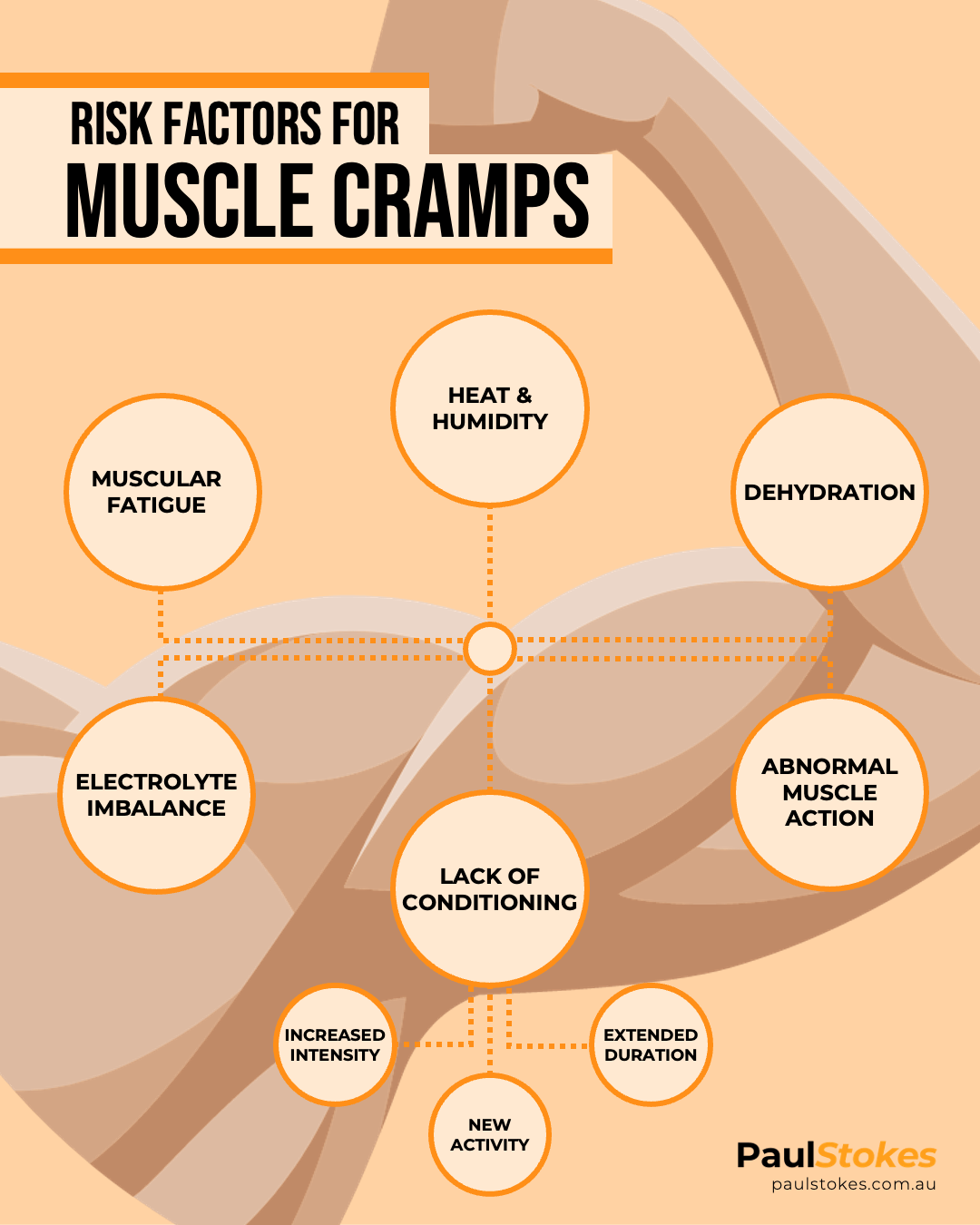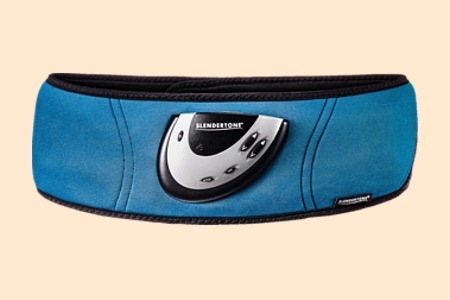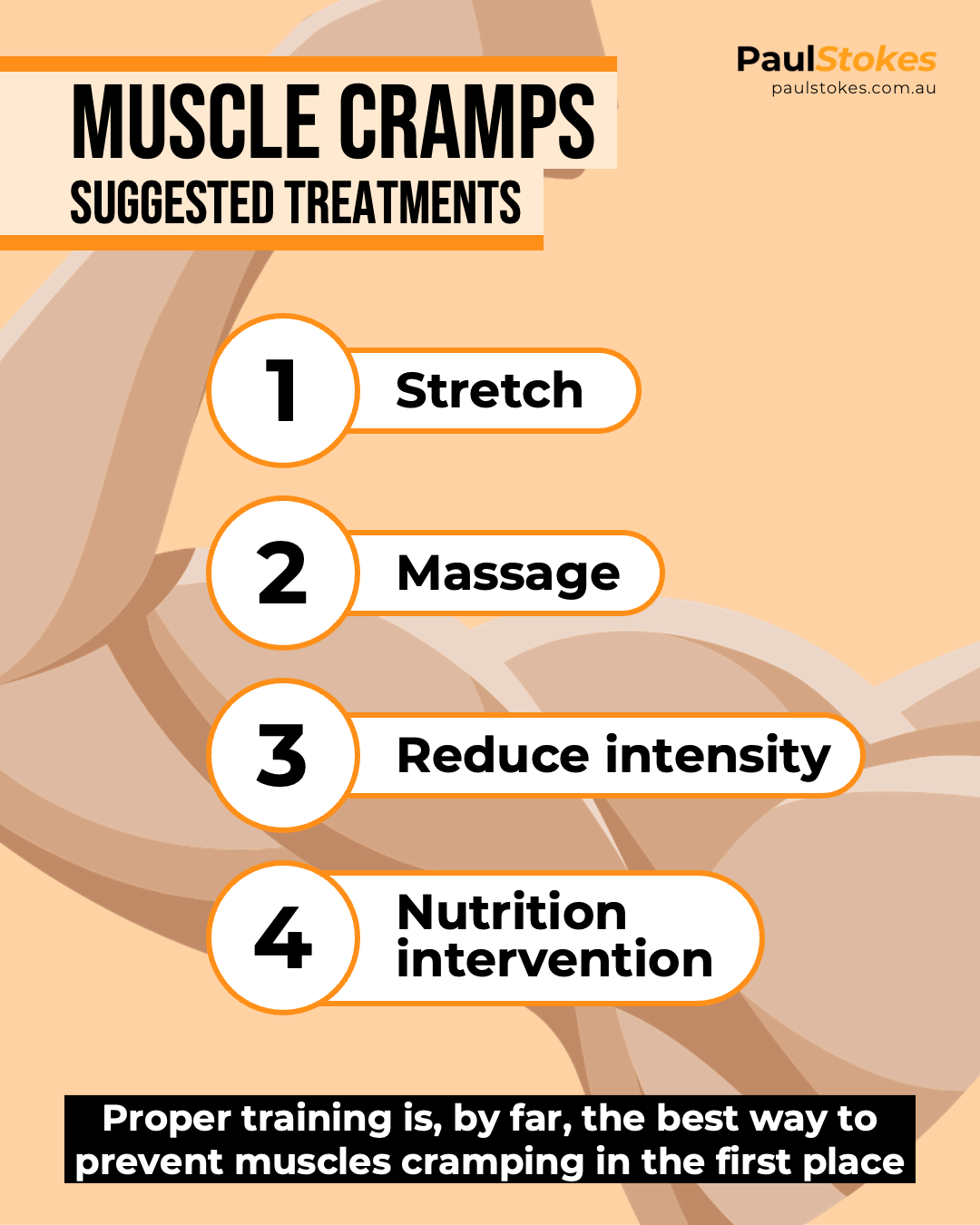Muscle cramps can be a common problem for athletes and those who exercise regularly. That sudden, sharp, painful and uncontrolled muscle contraction is the feeling no one wants. Obviously, they negatively affect performance. And they hurt! Find out some tips & strategies you might use in your next workout to avoid your muscles cramping either during or after your exercise session.
More...
How common are muscle cramps, and are there different types?
I'm sure at some point, either while training or playing sport, you've experienced some sort of muscle cramp.
We don't quite know how many athletes suffer from muscles cramp as we just don't have the data. It isn't really tracked on a large scale in mainstream sports. Furthermore, some athletes and professional sport players may only get occasional muscle cramps during an exercise session. Conversely, some people may experience frequent cramps in the muscles during workouts.
People also experience muscle cramps differently. Sometimes they are only minor cramps in the smaller muscle groups. These tend to resolve fairly quickly and don't cause many ongoing issues. On the other hand, some muscle cramps can extend over several large muscle groups and result in pain over the course of a few hours or more.
While scientific studies have looked into the matter, they aren't that conclusive. There doesn't seem to be a general consensus as to what a cramp is and therefore what counts and what doesn't. As an example, in triathlon, a large study involving 2600 triathletes found that two thirds report some form of muscle cramp either during or after exercise. Additionally, 4% were found to experience severe cramps during or after their workouts.
What factors increase my risk of getting a muscle cramp while I exercise?
Generally speaking, muscle cramping tends to occur more commonly during endurance sports and events. That is, long duration repetitive actions over an extended period of time. However, muscles can cramp during any sporting activity or gym exercise.
Exercise scientists identify several risk factors that may increase your likelihood of experience muscle cramps:
We must note though that these factors only indicate with experiencing a muscle cramp. They don't necessarily point to the direct cause as to why the muscle(s) cramps in the first place.
With all that said, there appears to be 2 main theories as to why muscles cramp during exercise.

Essentially, two different types of muscle cramps are common. In exercise physiology, we refer to them as heat cramps and exercise-induced muscle cramps. We'll look into each of these in more detail shortly.
As a general rule, we normally experience heat cramps in the larger muscle groups of the limbs and extremeties. Also, they might occur around the core and abdomen. Usually, they'll start with a light tingling sensation before progressing to a stronger contraction in a particular part of the muscle. This heat cramp then seems to spread through the muscle.
In contrast, exercise-induced muscle cramps tend to affect the entire muscle at once.
How electrolyte levels and your hydration status may affect muscle cramps during exercise
Growing up, this was the most common cause given for cramping muscles. And it makes sense. After all, exercise causes us to sweat. As you probably know, sweat contains different kinds of salt known as electrolytes. Essentially, electrolytes help conduct the nerve impulses from your brain cells to the working muscles. If the electrolyte levels drop, these signals become scrambled which result in the muscles cramping. To put it another way, cramping is due to your muscles contracting uncontrollably.
Many textbooks and medical references give 'muscle cramps' as a sign or symptom of dehydration.
Traditionally, muscles cramps are thought to be caused by dehydration and losing electrolytes through sweat during exercise.
Interestingly, scientists were looking at and studying this effect almost 100 years ago!
Research into muscle cramps and dehydration goes back to the 1920 and 30s
Researchers looked at workers in the heavy industries of the day. For example, those working in the steel mill, miners and ship builders. These people, predominantly men, worked very physically demanding jobs. Additionally, conditions were hot and humid with furnaces raging. Furthermore, the workers were dressed in thick protective clothing and coveralls.
They figured that cramps were due to workers losing electrolytes since they were sweating so much. However, since the workers were drinking large volumes of water, dehydration wasn't always a consideration.
As a result, they found that low sodium levels in the blood could trigger muscle cramps. Researchers found that in a particular steel mill where workers were given sodium in their drinks, they experienced far less cases of cramp.
In athletes, we see that those who suffer from frequent muscle cramps tend to lose more sodium during their exercise sessions. In addition, they usually tend to drink plain water rather than any sports drinks formulated with electrolytes.
Exercised induced muscle cramps may be due to faults in nerve signals
We've discussed how exercising in hot, humid conditions without adequate hydration and electrolyte levels can lead to muscle cramps.
However, athletes and gym goers also suffer from muscle cramps in cooler environments even when they are well hydrated. Therefore, there must be something else at play to cause these types of cramps.
It doesn't necessarily have to be what we think of as exercise that triggers muscle cramps. For example, many repetitive activities using only small muscle groups like typing, writing, cooking, cleaning can cause cramps.
Exercise scientists suggest these types of cramps may be due to faults in the nerve impulses sent to the muscles. Basically, when we use our muscles, our brain (or Central Nervous System, CNS) decides which muscles need to contract. Next, an electrical signal is sent down through our nerve cells to the particular muscle, or group of muscles. From here, that impulse causes contraction of particular bundles of fibres within the muscle cell.
If we're exercising and need to generate a lot of force, like when lifting a heavy weight, our brain sends more of these impulses.
It's thought that when carrying out repetitive tasks, muscles can become fatigued and so our brain has to send signals to different muscle units to get them to do the work instead. At the same, control systems within your body that are supposed to stop excessive muscle contraction may also fatigue and become less effective.
The net result is that your muscles may cramp as the signals sent to them are now uncontrolled.
We're still not quite sure this is the case though
It's difficult to study and analyse exactly what's going on in these situations though. Exercise-induced muscle cramps can be sporadic and occur seemingly out of nowhere, making them hard to predict.
We do know that we can generate cramps within muscles via electrical stimulation.
Around the mid-90s and early 2000s, there were all manner of home use Electrical Muscle Stimulation (EMS) devices available. Indeed, they are still available today, albeit less common.

EMS devices like the Slendertone were all-the-rage in the late 90s and early 2000s
When electrodes are placed against the skin, we can stimulate the underlying muscles to contract with a relatively weak electric current. We can induce cramps using this EMS in a controlled manner, targeting specific muscle groups.
Exercise scientists quickly found that no level of hydration or electrolyte consumption could prevent these types of cramps. Interestingly, when athletes were tested, those who tended to suffer from exercise-induced muscle cramps more often required less electrical stimulation to trigger cramps than other people.
Additionally, when given anaesthetic to 'switch off' the nerves, they needed more electrical stimulation to induce a cramp.
This evidence points to electrical and nerve-related issues being an underlying cause of muscle cramps. However, it's unclear whether this research using electrically stimulated muscle cramps holds up to what happens in cramps caused by exercise.
What causes muscle cramps?
Muscle cramps are definitely more common during intense exercise in hot and humid conditions. High sweat rates and loss of electrolytes often result in muscular spasms and cramps.
However, muscle cramps also happen when we're not dehydrated or exercising in the heat. In these cases, it's likely the cramps are caused by faults in the electrical signals between the nerves and muscles.
How can you prevent muscle cramps while you exercise, or treat them if they occur?
As you probably know, if your muscles cramp up during exercise, you won't perform at your best. Certainly, cramps occur more commonly among endurance athletes and long duration events. That's not to say though that cramps can't come on during shorter workouts or exercise sessions.
Preventing exercise-induced muscle cramps
As we've discussed above, one of the commonly suggested causes of muscle cramps is down to electrolytes. More specifically, an imbalance in their levels, particularly with regard to sodium. Remember, sodium is one of the main minerals we lose in our sweat.
Our body needs electrolytes to allow us to properly contract and relax our muscles (among other things).
We can lower our risk of developing muscle cramps by maintaining a good electrolyte balance. To do this, we should look towards sports drinks and formulations which aim to replace electrolyte losses from excess sweating. Plain water may not be enough.
Ideally, we want to avoid a large deficit in our electrolyte levels come the end of our training session.
Training and conditioning may be crucial to help prevent muscle cramps
Also, we must remember that our muscles adapt and respond to the demands that we place on them. If we are specific in how we train, we can help our body and muscles cope with more demanding conditions.
We know that fatigue is a factor, especially when we consider how it affects nerve impulse relays to the muscles.
If a cramp takes hold during an exercise session, then we want to get the muscle to relax.
It follows then that if we train our muscles properly, they will be able to withstand longer duration exercise. Consequently, we'll experience less of this fatigue.
If you compete, try to mimic the same conditions in your training sessions that you experience during competition. The same time of day, intensity, environment, temperature, etc.
Additionally, we can look at our movement patterns and try to engage different muscles as we go. This will mean those muscles that are previously untrained, or certainly less trained, get to experience similar demands and can build up resistance to fatigue accordingly.

Ways to treat muscle cramps while exercising
Now let's look at some ways to deal with, and treat, muscle cramps as they occur. We should remember though that once a muscle starts to cramp, there isn't a whole lot we can do to treat it.
Reducing exercise intensity
Most cramps will resolve themselves. Often, they'll only last a few seconds, or perhaps minutes.
If a cramp takes hold during an exercise session, then we want to get the muscle to relax. To do this, we can either rest or reduce our pace or intensity for a short time. This allows the cramp to fade and will probably be a sufficient strategy for most minor cramps.
However, sometimes a cramp occurs in a muscle you don't even think you are using!
For example, when running, you might experience cramps in your arms or even your hands. In this case, you might not even need to reduce your intensity or slow down. It's likely things will resolve themselves.
Stretching the muscle to alleviate cramps
Often, when we experience a strong cramping sensation, our instinctive response is to try and stretch the affected muscle.
I find this interesting, since it's what our bodies naturally tell us to do. Effectively, we have a muscle that is over contracting so it makes sense we want to stretch it to help it lengthen.
It turns out that this response makes sense on a physiological level too.
When we stretch, we activate specific structures within our muscle cells called the Golgi Tendon Organs. If you've ever performed PNF Stretching, you're taking advantage of these structures too.
Once activated, the golgi tendon organs signal to the muscle to stop, or at least reduce, their contraction. In theory, this should reduce the pain and intensity of a muscle cramp.
At this stage, there isn't a lot of strong evidence to support stretching as an effective treatment for cramps. In saying that, this comes down to the nature of muscle cramps in the first place. They're hard to predict and often resolve quickly on their own, without any intervention. Therefore, it's hard to measure what effect, if any, stretching has on a muscle once it's gone into cramp.
However, even it it's not 'proven' to help, stretching is one of the few things we can do to offer any relieve from muscle cramps. This is especially true when we are dealing with a particularly painful or long-lasting cramp.
Nutrition interventions to help prevent and treat muscle cramps
We know that electrolytes and fatigue are factors in the likelihood of experiencing muscle cramps. As a result, we can look to use the principles of good nutrition to fuel our bodies properly.
Generally speaking, we want a diet rich in vegetables, fruits and legumes to allow an adequate supply of minerals. Remember, electrolytes aren't just in specially formulated sports drinks. We get them from food too.
Additionally, ensuring our muscles are properly fueled for each specific workout can go a long way to diminishing the effects of fatigue.
Obviously, there are also specially formulated sports drinks on the market designed to tackle both issues. Drinks such as Gatorade tend to include carbohydrate as a source of fuel for muscles as well as sodium and other electrolytes. It may be work considering whether one of these would be a valuable tool in your sports diet.
There have been claims that items like pickle juice can prevent cramps too. The theory goes that since it contains sodium it would help. Research indicates though that pickle juice doesn't have an effect on electrolyte balance. People also claim that the high vinegar content may stimulate certain nerves in the mouth which dull the cramp response. There is little evidence to support this claim so it appears at this stage that the benefits of pickle juice may be down to the placebo effect rather than physiology.

References and further reading
If you'd like to know more and are keen on research, here are some links to relevant scientific research papers. Some links are to online journals while others are to the direct PDF download.
Heat Cramps
Talbott J.
Medicine. 14:323-76, 1935
Mechanisms of cramp contractions: peripheral or central generation
Minetto M, Holobar A, Botter A, Ravenni R, Farina D.
J Physiol. 589(23):5759-7, 2011
Muscle Cramping During Exercise: Causes, Solutions, and Questions Remaining
Maughan RJ, Shirreffs SM.
Sports Med. 49(Suppl 2):115-24, 2019
Influence of hydration and electrolyte supplementation on incidence and time to onset of exercise-associated muscle cramps
Jung A, Bishop P, Al-Nawwas A, Dale R.
Journal of Athletic Training. 40(2):71-5, 2005
Acute passive static stretching and cramp threshold frequency
Panza G, Stadler J, Murray D, Lerma N, Barrett T, Pettit-Mee R, Edwards J.
Journal of Athletic Training. 52(10):918-24, 2017
Prophylactic stretching does not reduce cramp susceptibility
MIller K, Harsen J, Long B.
Muscle Nerve. 57(3):473-7, 2018
Electrolyte and plasma changes after ingestion of pickle juice, water, and a common carbohydrate- electrolyte solution
MIller K, Mack G, Knight K.
Journal of Athletic Training. 44(5):454-61, 2009

Good post! We will be linking to this particularly great post on our site. Keep up the great writing